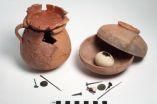(Press-News.org) Scientists have created an ingenious computer model that simulates a honey bee colony over the course of several years. The BEEHAVE model, published today in the Journal of Applied Ecology, was created to investigate the losses of honeybee colonies that have been reported in recent years and to identify the best course of action for improving honeybee health.
A team of scientists, led by Professor Juliet Osborne from the Environment and Sustainability Institute, University of Exeter (and previously at Rothamsted Research), developed BEEHAVE, which simulates the life of a colony including the queen's egg laying, brood care by nurse bees and foragers collecting nectar and pollen in a realistic landscape.
Professor Juliet Osborne said: "It is a real challenge to understand which factors are most important in affecting bee colony growth and survival. This is the first opportunity to simulate the effects of several factors together, such as food availability, mite infestation and disease, over realistic time scales."
The model allows researchers, beekeepers and anyone interested in bees, to predict colony development and honey production under different environmental conditions and beekeeping practices. To build the simulation, the scientists brought together existing honeybee research and data to develop a new model that integrated processes occurring inside and outside the hive.
The first results of the model show that colonies infested with a common parasitic mite (varroa) can be much more vulnerable to food shortages. Effects within the first year can be subtle and might be missed by beekeepers during routine management. But the model shows that these effects build up over subsequent years leading to eventual failure of the colony, if it was not given an effective varroa treatment.
BEEHAVE can also be used to investigate potential consequences of pesticide applications. For example, the BEEHAVE model can simulate the impact of increased loss of foragers. The results show that colonies may be more resilient to this forager loss than previously thought in the short-term, but effects may accumulate over years, especially when colonies are also limited by food supply.
BEEHAVE simulations show that good food sources close to the hive will make a real difference to the colony and that lack of forage over extended periods leaves them vulnerable to other environmental factors. Addressing forage availability is critical to maintaining healthy hives and colonies over the long term.
Professor Osborne added: "The use of this model by a variety of stakeholders could stimulate the development of new approaches to bee management, pesticide risk assessment and landscape management. The advantage is that each of these factors can be tested in a virtual environment in different combinations, before testing in the field. Whilst BEEHAVE is mathematically very complex, it has a user-friendly interface and a fully accessible manual so it can be explored and used by a large variety of interested people".
BEEHAVE is freely available at http://www.beehave-model.net.
The project was funded by an Industrial Partnership Award from BBSRC with co-funding from Syngenta. It involved collaboration between ecologists and modellers from Exeter (Professor Osborne, Dr Becher and Dr Kennedy, who started the project at Rothamsted Research), Helmholtz Centre for Environmental Research - UFZ Leipzig (Professor Grimm and Ms Horn) and Syngenta (Dr P Thorbek).
Professor Osborne's research group studies the behaviour and ecology of bees and other pollinators. They started the project when based at Rothamsted Research and moved to the University of Exeter in 2012. They work with beekeepers, conservation organisations, farmers and industry with the aim of conserving bee populations, and protecting and promoting wild flower and crop pollination.
Professor Melanie Welham, BBSRC's Science Director, said: "Healthy bees are vital to our food supply as they pollinate many important crops. This virtual hive is an important new research tool to help us understand how changes to the environment impact on bee health."
Dr Pernille Thorbek (Syngenta) adds: "Studying several stressors in multifactorial field trials is immensely complicated and difficult to do. BEEHAVE is an important new tool which can simulate and explore interactions between stressors and can improve understanding and focus experimental work."
"BEEHAVE can help explore which changes to agricultural landscapes and beekeeping practices will benefit honeybees the most."
Dr David Aston, President of the British Beekeepers Association, commented that: "This model will be an important tool in helping us to understand the interactions and impact of the diverse stressors to which honey bee colonies can be exposed.
"Not only will it be invaluable for scientific research purposes but it will also be an important training tool to help beekeepers better understand the impacts of their husbandry and other factors on the health and survival of their colonies.
INFORMATION: END
Virtual bees help to unravel complex causes of colony decline
New computer model to help scientists, beekeepers and regulators to understand multiple environmental effects on honeybee colonies
2014-03-04
ELSE PRESS RELEASES FROM THIS DATE:
Sardis dig yields enigmatic trove: Ritual egg in a pot
2014-03-04
MADISON, Wis. — By any measure, the ancient city of Sardis — home of the fabled King Croesus, a name synonymous with gold and vast wealth, and the city where coinage was invented — is an archaeological wonder.
The ruins of Sardis, in what is now Turkey, have been a rich source of knowledge about classical antiquity from the 7th century B.C., when the city was the capital of Lydia, through later Greek and Roman occupations.
Now, however, Sardis has given up another treasure in the form of two enigmatic ritual deposits, which are proving more difficult to fathom than ...
World-class orchestras judged by sight not sound
2014-03-04
World-class orchestras can be accurately identified by silent video footage of performances, but not through sound recordings, a UCL study has found.
Both professional musicians and musical novices are better at identifying top-ranked orchestras from non-ranked orchestras when shown silent video footage, suggesting that such judgements are driven at least in part by visual cues about group dynamics and leadership.
When shown two 6-second clips, one from a world-class orchestra ranked among the top ten internationally - which included the London Symphony Orchestra, the ...
Plant extract offers hope for infant motor neurone therapy
2014-03-04
A chemical found in plants could reduce the symptoms of a rare muscle disease that leaves children with little or no control of their movements.
Scientists have found that a plant pigment called quercetin – found in some fruits, vegetables, herbs and grains – could help to prevent the damage to nerves associated with the childhood form of motor neuron disease.
Their findings could pave the way for new treatments for spinal muscular atrophy (SMA) – also known as floppy baby syndrome – which is a leading genetic cause of death in children.
The team has found that the ...
Yeast model reveals Alzheimer's drug candidate and its mechanism of action
2014-03-04
CAMBRIDGE, Mass. (March 3, 2014) – Using a yeast model of Alzheimer's disease (AD), Whitehead Institute researchers have identified a drug that reduces levels of the toxic protein fragment amyloid-β (Aβ) and prevents at least some of the cellular damage caused when Aβ accumulates in the brains of AD patients.
"We can use this yeast model to find small molecules that will address the underlying cellular pathologies of Alzheimer's, an age-related disease whose burden will become even more significant as our population grows older," says Kent Matlack, a former ...
Childhood adversity launches lifelong relationship and health disadvantages for black men
2014-03-04
AUSTIN, Texas — African American men who endured greater childhood adversity are likely to experience disadvantages in health and relationships over time, according to new sociology research from The University of Texas at Austin.
The study, published in the March issue of the Journal of Health and Social Behavior, helps to explain why African American men are less healthy than white men.
"Exposure to childhood adversity may cause stress and lead to a sequence of stressors over time that take a cumulative toll on relationships," says Debra Umberson, professor of sociology ...
Two studies examine bedroom TVs, active gaming and weight issues in children
2014-03-04
Bottom Line: Having a bedroom television is associated with weight gain in children and adolescents, and is unrelated to the time they spend watching.
Author: Diane Gilbert-Diamond, Sc.D., of the Geisel School of Medicine at Dartmouth, Lebanon, N.H., and colleagues.
Background: More than one-third of children and adolescents in the United States are overweight or obese. An estimated 71 percent of children and adolescents (ages 8 to 18 years) have bedroom televisions.
How the Study Was Conducted: The authors conducted a telephone survey in 2003 of 6,522 boys and girls ...
New research on potent HIV antibodies has opened up possibilities
2014-03-04
The discovery of how a KwaZulu-Natal woman's body responded to her HIV infection by making potent antibodies (called broadly neutralising antibodies, because they are able to kill multiple strains of HIV from across the world), was reported today by the CAPRISA consortium of AIDS researchers jointly with scientists from the United States.
The study, published in the prestigious scientific journal, Nature, describes how the research team found and identified these antibodies in her blood and then duplicated them by cloning the antibodies in the laboratory. The cloned antibodies ...
Distinctive flashing patterns might facilitate fish mating
2014-03-04
Scientists have shown for the first time that deep-sea fishes that use bioluminescence for communication are diversifying into different species faster than other glowing fishes that use light for camouflage. The new research indicates that bioluminescence—a phenomenon in which animals generate visible light through a chemical reaction—could promote communication and mating in the open ocean, an environment with few barriers to reproduction. The study was recently published in the journal Marine Biology.
"Bioluminescence is quite common in the deep sea, and many fishes ...
Quality of life improves with minimally invasive surgery for low back pain
2014-03-04
Beaumont research findings published in the February online issue of Spine shows that patients who have a low back surgery called minimally invasive transforaminal lumbar interbody fusion, end up better off in many ways than patients who have more invasive surgery to alleviate debilitating pain.
"About 90 percent of adults experience low back pain in their lifetime, which can be caused by spinal instability, stenosis, spondylolisthesis, and symptomatic degenerative disc disease," says Mick Perez-Cruet, M.D., neuro-spine surgeon at Beaumont Hospital, Royal Oak and professor, ...
Exercising during pregnancy reduces excessive weight gain and associated illnesses
2014-03-04
This news release is available in Spanish. Excessive weight gain during pregnancy increases the risk of suffering illnesses such as hypertension and gestational diabetes, or of having a premature birth or a birth by Caesarean; furthermore, it also has negative effects on the newly-born and increases the risk of infants being overweight by 30%.
Aware of the importance of preventing gestational weight gain, both in mother and child, researchers from the University of Granada, Madrid Polytechnic University and the European University carried out a study on the benefits ...
LAST 30 PRESS RELEASES:
There are new antivirals being tested for herpesviruses. Scientists now know how they work
CDI scientist, colleagues author review of global burden of fungus Candida auris
How does stroke influence speech comprehension?
B cells transiently unlock their plasticity, risking lymphoma development
Advanced AI dodel predicts spoken language outcomes in deaf children after cochlear implants
Multimodal imaging-based cerebral blood flow prediction model development in simulated microgravity
Accelerated streaming subgraph matching framework is faster, more robust, and scalable
Gestational diabetes rose every year in the US since 2016
OHSU researchers find breast cancer drug boosts leukemia treatment
Fear and medical misinformation regarding risk of progression or recurrence among patients with breast cancer
Glucagonlike peptide-1 receptor agonists and asthma risk in adolescents with obesity
Reviving dormant immunity: Millimeter waves reprogram the immunosuppressive microenvironment to potentiate immunotherapy without obvious side effects
Safety decision-making for autonomous vehicles integrating passenger physiological states by fNIRS
Fires could emit more air pollution than previously estimated
A new way to map how cells choose their fate
Numbers in our sights affect how we perceive space
SIMJ announces global collaborative book project in commemoration of its 75th anniversary
Air pollution exposure and birth weight
Obstructive sleep apnea risk and mental health conditions among older adults
How talking slows eye movements behind the wheel
The Ceramic Society of Japan’s Oxoate Ceramics Research Association launches new international book project
Heart-brain connection: international study reveals the role of the vagus nerve in keeping the heart young
Researchers identify Rb1 as a predictive biomarker for a new therapeutic strategy in some breast cancers
Survey reveals ethical gaps slowing AI adoption in pediatric surgery
Stimulant ADHD medications work differently than thought
AI overestimates how smart people are, according to HSE economists
HSE researchers create genome-wide map of quadruplexes
Scientists boost cell "powerhouses" to burn more calories
Automatic label checking: The missing step in making reliable medical AI
Low daily alcohol intake linked to 50% heightened mouth cancer risk in India
[Press-News.org] Virtual bees help to unravel complex causes of colony declineNew computer model to help scientists, beekeepers and regulators to understand multiple environmental effects on honeybee colonies




